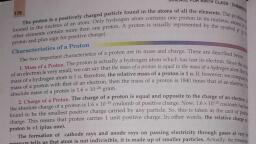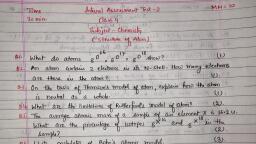Question 2 :
In 1911, __________ came to the conclusion that the atom had a dense nucleus because most of the particles shot straight through, but some of the particles were deflected due to the dense nucleus of the gold atoms.
Question 3 :
Valency is the number of electrons accepted by a noble gas.
Question 5 :
An atom or group of atoms of the same or of different elements that behaves as a single unit with a positive or negative charge is known as :
Question 6 :
According to Rutherford, the electron revolves around the nucleus in definite orbits but :
Question 7 :
Which of the following was carried out by Rutherford in his experiment?
Question 9 :
Maximum no. of electrons that can be present in M & N shells respectively are ________.
Question 10 :
According to whose atomic model, electrons are embedded in a gel of positive charge?
Question 16 :
J.J. Thomson's atomic model could not justify the shielding of electrons from positive charges.
Question 17 :
<p>Which one of these configurations tends to gain, lose or share electrons?</p>
Question 18 :
In 1932, ___________ discovered an electrically neutral particle in the atom named as neutron.
Question 19 :
The electron which is newly added to the atom in the outer most shell of an atom is called the valence electron.<br/>
Question 21 :
Which of the following elements has three shells with no shells having even number of outer electrons?
Question 22 :
The maximum number of electrons in the third shell of an atom can be ________.
Question 23 :
The presence of nucleus in an atom is determined by Rutherford $\alpha - ray$ scattering experiment.<br/>
Question 24 :
Goldstein's work with anode rays of $H^+$ was apparently the first observation of the :
Question 26 :
Valency can be defined as the same number of hydrogen atoms or double the number of oxygen atoms that element combines with.
Question 27 :
The maximum number of electrons that can be accommodated in the outermost orbit is :
Question 30 :
Stability of an atom was successfully explained by Rutherford's atomic model.<br/>
Question 31 :
A species having only one electron has ionization energy of $11810\quad { mol }^{ -1 }$. The number of protons in its nucleus will be:
Question 32 :
For a monoatomic ion, the net charge on the atom is its valency.
Question 36 :
An element X has $7$ electrons in its L shell. What is true about the element?<br/>I. It belongs to period $9$ of a modern periodic table.<br/>II. Its atom contains $9$ protons.<br/>III. It has a valency of $7$.<br/>IV. Its atoms can accept one electron to acquire noble gas configuration.<br/>
Question 37 :
The number of electrons present in the valance shell of central atom of methyl carbocation is:
Question 38 :
The letters X, Y and Z represent different atoms.<br/><blockquote>40            39           40<br/>    X              Y             Z<br/>19            19           20<br/></blockquote>What can be deducted from the proton numbers and nucleon numbers of X, Y, and Z?
Question 39 :
Which of the following pair of symbols represents nuclei that have the same number of neutrons?































